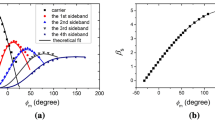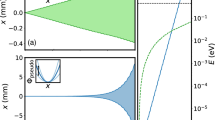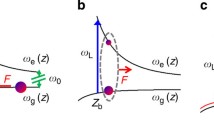Abstract
We report on the compensation of excess micromotion due to parasitic rf-electric fields in a Paul trap. The parasitic rf-electric fields stem from the Paul trap drive but cause excess micromotion, e.g., due to imperfections in the setup of the Paul trap. We compensate these fields by applying rf-voltages of the same frequency, but adequate phases and amplitudes to Paul trap electrodes. The magnitude of micromotion is probed by studying elastic collision rates of the trapped ion with a gas of ultracold neutral atoms. Furthermore, we demonstrate that also reactive collisions can be used to quantify micromotion. We achieve compensation efficiencies of about 1 \(\,\text {Vm}^{-1}\), which is comparable to other conventional methods.






Similar content being viewed by others
Notes
In a perfectly aligned linear Paul trap with vanishing rf-potentials on the endcaps such a symmetric rf-drive leads to a vanishing axial micromotion on the trap axis. We note that in our previous work [19] we used an asymmetric trap drive.
Measurements of the electrode voltages indicate, however, that the voltage amplitude \(V_0\) for the electrode pair (e1, e2) and the pair (e3, e4) are not equal but \(160\,\text {V}\) and \(143\,\text {V}\), respectively. Therefore, a cancellation of micromotion along the axial direction might be compromised. A simulation of the electrical fields for our setup can be found in [23].
We note that besides applying ac-voltages to compensation electrodes, also alternative compensation methods could be used. For example, phase delays can be implemented by adjusting cable lengths or by using additional capacitances similarly as in [24].
This trap does not have to exhibit perfect rotational symmetry.
We restrict the discussion to the quasi-static regime where dynamical coupling of \(\boldsymbol{\mathcal{E}}\)- and \(\boldsymbol{\mathcal{B}}\)-fields (e.g., induction) can be neglected.
References
H. Häffner, C.F. Roos, R. Blatt, Phys. Rep. 469, 155 (2008). https://doi.org/10.1016/j.physrep.2008.09.003
A. Bermudez, P. Schindler, T. Monz, R. Blatt, M. Müller, New J. Phys. 19, 113038 (2017). https://doi.org/10.1088/1367-2630/aa86eb
M. Johanning, A.F. Varón, C. Wunderlich, J. Phys. B: At. Mol. Opt. Phys. 42, 154009 (2009). https://doi.org/10.1088/0953-4075/42/15/154009
D.J. Wineland, W.M. Itano, J.C. Bergquist, R.G. Hulet, Phys. Rev. A 36, 2220 (1987). https://doi.org/10.1103/PhysRevA.36.2220
A.L. Wolf, S.A. van den Berg, C. Gohle, E.J. Salumbides, W. Ubachs, K.S.E. Eikema, Phys. Rev. A 78, 032511 (2008). https://doi.org/10.1103/PhysRevA.78.032511
A.D. Ludlow, M.M. Boyd, J. Ye, E. Peik, P.O. Schmidt, Rev. Mod. Phys. 87, 637 (2015). https://doi.org/10.1103/RevModPhys.87.637
M. Tomza, K. Jachymski, R. Gerritsma, A. Negretti, T. Calarco, Z. Idziaszek and P. S.Julienne, arXiv:1708.07832 (2017)
A. Härter, J. Hecker Denschlag, Contemp. Phys. 55, 33 (2014). https://doi.org/10.1080/00107514.2013.854618
D. Zhang and S. Willitsch, Chap. 10 in: Cold chemistry: molecular scattering and reactivity near absolute zero (edited by O. Dulieu and A. Osterwalder), RSC Publishing (2017). https://doi.org/10.1039/9781782626800
D.J. Berkeland, J.D. Miller, J.C. Bergquist, W.M. Itano, D.J. Wineland, J. Appl. Phys. 83, 5025 (1998). https://doi.org/10.1063/1.367318
D.T.C. Allcock, J.A. Sherman, D.N. Stacey, A.H. Burrell, M.J. Curtis, G. Imreh, N.M. Linke, D.J. Szwer, S.C. Webster, A.M. Steane, D.M. Lucas, New J. Phys. 12, 053026 (2010). https://doi.org/10.1088/1367-2630/12/5/053026
B.L. Chuah, N.C. Lewty, R. Cazan, M.D. Barret, Opt. Express 21, 10632 (2013). https://doi.org/10.1364/OE.21.010632
T.F. Gloger, P. Kaufmann, D. Kaufmann, M.T. Baig, T. Collath, M. Johanning, C. Wunderlich, Phys. Rev. A 92, 043421 (2015). https://doi.org/10.1103/PhysRevA.92.043421
U. Tanaka, K. Masuda, Y. Akimoto, K. Koda, Y. Ibaraki, S. Urabe, Appl. Phys. B 107, 907 (2012). https://doi.org/10.1007/s00340-011-4762-2
S. Narayanan, N. Daniilidis, S.A. Möller, R. Clark, F. Ziesel, K. Singer, F. Schmidt-Kaler, H. Häffner, J. Appl. Phys. 110, 114909 (2011). https://doi.org/10.1063/1.3665647
J. Keller, H.L. Partner, T. Burgermeister, T.E. Mehlstäubler, J. Appl. Phys. 118, 104501 (2015). https://doi.org/10.1063/1.4930037
Z. Meir, T. Sikorsky, R. Ben-shlomi, N. Akerman, M. Pinkas, Y. Dallal, R. Ozeri, J. Mod. Opt. 65, 501 (2017). https://doi.org/10.1080/09500340.2017.1397217
T. Huber, A. Lambrecht, J. Schmidt, L. Karpa, T. Schaetz, Nat. Commun. 5, 5587 (2014). https://doi.org/10.1038/ncomms6587
A. Härter, A. Krükow, A. Brunner, J. Hecker Denschlag, Appl. Phys. Lett. 102, 221115 (2013). https://doi.org/10.1063/1.4809578
Z. Meir, T. Sikorsky, R. Ben-shlomi, N. Akerman, Y. Dallal, R. Ozeri, Phys. Rev. Lett. 117, 243401 (2016). https://doi.org/10.1103/PhysRevLett.117.243401
S. Schmid, A. Härter, A. Frisch, S. Hoinka, J. Hecker Denschlag, Rev. Sci. Instrum. 83, 053108 (2012). https://doi.org/10.1063/1.4718356
A. Härter, Two-body and three-body dynamics in atom-ion experiments. Ph.D. thesis, Universität Ulm (2013)
A. Brunner, Excess Micromotion in Atom-Ionen Experimenten. Diploma thesis, Universität Ulm (2012)
P.F. Herskind, A. Dantan, M. Albert, J.P. Marler, M. Drewsen, J. Phys. B: At. Mol. Opt. Phys. 42, 154008 (2009). https://doi.org/10.1088/0953-4075/42/15/154008
M. Cetina, A.T. Grier, V. Vuletić, Phys. Rev. Lett. 109, 253201 (2012). https://doi.org/10.1103/PhysRevLett.109.253201
H.A. Fürst, N.V. Ewald, T. Secker, J. Joger, T. Feldker, R. Gerritsma, J. Phys. B: At. Mol. Opt. Phys. 51, 195001 (2018). https://doi.org/10.1088/1361-6455/aadd7d
L.H. Nguyên, A. Kalev, M.D. Barrett, B.-G. Englert, Phys. Rev. A 85, 052718 (2012). https://doi.org/10.1103/PhysRevA.85.052718
B. Höltkemeier, P. Weckesser, H. López-Carrera, M. Weidemüller, Phys. Rev. Lett. 116, 233003 (2016). https://doi.org/10.1103/PhysRevLett.116.233003
C. Zipkes, L. Ratschbacher, C. Sias, M. Köhl, New J. Phys. 13, 053020 (2011). https://doi.org/10.1088/1367-2630/13/5/053020
S. Haze, M. Sasakawa, R. Saito, R. Nakai, T. Mukaiyama, Phys. Rev. Lett. 120, 043401 (2018). https://doi.org/10.1103/PhysRevLett.120.043401
K. Ravi, S. Lee, A. Sharma, G. Werth, S.A. Rangwala, Nat. Commun. 3, 1126 (2012). https://doi.org/10.1038/ncomms2131
S. Dutta, R. Sawant, S.A. Rangwala, Phys. Rev. Lett. 118, 113401 (2017). https://doi.org/10.1103/PhysRevLett.118.113401
I. Rouse, S. Willitsch, Phys. Rev. A 97, 042712 (2018)
A. Krükow, A. Mohammadi, A. Härter, J. Hecker Denschlag, J. Pérez-Ríos, C.H. Greene, Phys. Rev. Lett. 116, 193201 (2016). https://doi.org/10.1103/PhysRevLett.116.193201
A. Krükow, A. Mohammadi, A. Härter, J. Hecker Denschlag, Phys. Rev. A 94, 030701(R) (2016). https://doi.org/10.1103/PhysRevA.94.030701
R. Côté, A. Dalgarno, Phys. Rev. A 62, 012709 (2000). https://doi.org/10.1103/PhysRevA.62.012709
M.D. Gregoire, I. Hromada, W.F. Holmgren, R. Trubko, A.D. Cronin, Phys. Rev. A 92, 052513 (2015). https://doi.org/10.1103/PhysRevA.92.052513
H. da Silva Jr, M. Raoult, M. Aymar, O. Dulieu, New J. Phys. 17, 045015 (2015). https://doi.org/10.1088/1367-2630/17/4/045015
T. Secker, N. Ewald, J. Joger, H. Fürst, T. Feldker, R. Gerritsma, Phys. Rev. Lett. 118, 263201 (2017). https://doi.org/10.1103/PhysRevLett.118.263201
Acknowledgements
This work was supported by the German Research Foundation (DFG, Deutsche Forschungsgemeinschaft) within SFB/TRR21 and grant DE 510/2-1.
Author information
Authors and Affiliations
Corresponding author
Additional information
Publisher's Note
Springer Nature remains neutral with regard to jurisdictional claims in published maps and institutional affiliations.
Appendix: Some general considerations on compensating excess micromotion
Appendix: Some general considerations on compensating excess micromotion
Here, we discuss in a very general way excess micromotion in a Paul trapFootnote 4. The motion of a confined ion is determined by the exposure to constant and rf-electrical fieldsFootnote 5. Concretely, we consider the three electrical fields \(\boldsymbol{\mathcal{E}}_c, \boldsymbol{\mathcal{E}}_{\cos }, \boldsymbol{\mathcal{E}}_{\sin }\), characteristic for a Paul trap. \(\boldsymbol{\mathcal{E}}_c (\mathbf {r})\) is time-independent, while \(\boldsymbol{\mathcal{E}}_{\cos }(\mathbf {r}) \propto \cos (\varOmega t)\) and \(\boldsymbol{\mathcal{E}}_{\sin }(\mathbf {r}) \propto \sin (\varOmega t)\) are quadrature components of the rf-field. The electrical fields \(\boldsymbol{\mathcal{E}}_c,\) \(\boldsymbol{\mathcal{E}}_{\mathrm{cos} }, \boldsymbol{\mathcal{E}}_{\mathrm{sin} }\) can each be Taylor expanded around the trap center position \(\mathbf {r}_0\). For each expansion the first term is a homogeneous offset field and the second term is a quadrupole field, followed by higher multipole terms such as the octupole field. In the Paul trap it is the quadrupole field which is used for trapping. For excess micromotion to vanish at \(\mathbf {r}_0\), we need \(\boldsymbol{\mathcal{E}}_c (\mathbf {r}_0) = \boldsymbol{\mathcal{E}}_{\mathrm{cos} }(\mathbf {r}_0) = \boldsymbol{\mathcal{E}}_{\mathrm{sin} } (\mathbf {r}_0) = 0\), which is equivalent to the vanishing of the respective offset field terms of the Taylor expansions. The remaining quadrupole fields at location \(\mathbf {r}\) in the direct vicinity of \(\mathbf {r}_0\) will generally dominate over the higher multipole fields, as long as \(\mathbf {r}- \mathbf {r}_0\) is much smaller than the distance to any of the trap electrodes. The total quadrupole field \(\boldsymbol{\mathcal{E}}_\text {qp}(\mathbf {r})\) (i.e., the sum of the three quadrupole fields) is fully determined by the second derivatives of the corresponding electrostatic potential \(\phi \), i.e., \(\boldsymbol{\mathcal{E}}_\text {qp}(\mathbf {r}) = H(\phi ) (\mathbf {r}-\mathbf {r}_0) \). Here, \(H(\phi )\) is the Hessian matrix of \(\phi \), i.e., \(H_{i,j}(\phi )={\partial ^2 \phi \over \partial x_i \partial x_j}\), where \(x_i, x_j \in \{ x, y, z \}\). Since \(H(\phi )\) is symmetric it can be diagonalized. In the corresponding coordinate system \(\{x', y', z'\}\) the electrical quadrupole field can be written as \(\boldsymbol{\mathcal{E}}_\text {qp} = a x' {\hat{x}}' + b y' {\hat{y}}' + c z' {\hat{z}}'\), similarly as in Eq. (1). Here, a, b, c are time-dependent coefficients. Therefore, the motions of the ion along directions \({\hat{x}}', {\hat{y}}', {\hat{z}}'\) are decoupled and can be described by Mathieu equations. Thus, the main requirements for a Paul trap are fulfilled.
To cancel the offset field components of each of the \(\boldsymbol{\mathcal{E}}_c, \boldsymbol{\mathcal{E}}_{\mathrm{cos} }, \boldsymbol{\mathcal{E}}_{\mathrm{sin} }\) fields at location \(\mathbf {r}_0\) we can use three compensation electrodes to which we apply suitable dc- and rf-voltages. These electrodes produce electrical fields at \(\mathbf {r}_0\) which are preferentially (but not necessarily) perpendicular to each other.
Rights and permissions
About this article
Cite this article
Mohammadi, A., Wolf, J., Krükow, A. et al. Minimizing rf-induced excess micromotion of a trapped ion with the help of ultracold atoms. Appl. Phys. B 125, 122 (2019). https://doi.org/10.1007/s00340-019-7223-y
Received:
Accepted:
Published:
DOI: https://doi.org/10.1007/s00340-019-7223-y




